| Pages:
1
..
43
44
45
46
47
..
68 |
Hennig Brand
International Hazard
    
Posts: 1284
Registered: 7-6-2009
Member Is Offline
Mood: No Mood
|
|
The copper for the liner was from a used piece of copper pipe, which may have even had a thin film of solder on one side. The thickness may not have
been perfectly uniform.
I think well over 90% of the mass and energy were in the projectile that went through the steel, through the main hole, judging by the size and depth
of the other spots on the target. From the little bit I have seen a bit of splatter is a common sight on a target hit by an EFP.
edit:
There is a lot of stress on the outer edge of the liner especially, which often results in breakup from what I have read. A lot of the liners designed
professionally use methods such as tapering (thinner towards outer edge) to prevent breakup and to facilitate more desirable slug formation (less mass
less force, F = ma). The detonation zone meets the liner center first and by the time the detonation zone meets the outer edge the center of the liner
has been accelerated to a very high velocity. The same forces that elongate and narrow the projectile can also pull it apart especially at the outer
edge when and where the forces are greatest.
[Edited on 12-7-2015 by Hennig Brand]
"A risk-free world is a very dull world, one from which we are apt to learn little of consequence." -Geerat Vermeij
|
|
|
nux vomica
Hazard to Others
  
Posts: 267
Registered: 18-7-2013
Member Is Offline
Mood: No Mood
|
|
Quote: Originally posted by Hennig Brand  | | I think well over 90% of the mass and energy were in the projectile that went through the steel, through the main hole, judging by the size and depth
of the other spots on the target. From the little bit I have seen a bit of splatter is a common sight on a target hit by an EFP.
|
Oh it just looked like there was more penetration in the other holes.
|
|
|
Hennig Brand
International Hazard
    
Posts: 1284
Registered: 7-6-2009
Member Is Offline
Mood: No Mood
|
|
It is a bit deeper than I thought, the deepest hole is approaching 1/4", but its diameter is much smaller than the main hole. Not a perfect single
projectile, but the charge still worked quite well I would judge.
Have a look at these videos. The targets all look to have been blasted with other small projectiles as well as the main large one.
note: I noticed in the first video in one place where they seem to have used the description of what happens in a Munroe effect shaped charge to
describe an EFP which is not exactly correct.
https://www.youtube.com/watch?v=Pbf7WEVzKcQ
<iframe sandbox width="420" height="315" src="https://www.youtube.com/embed/Pbf7WEVzKcQ" frameborder="0" allowfullscreen></iframe>
https://www.youtube.com/watch?v=ir4Sppsi5KM
<iframe sandbox width="560" height="315" src="https://www.youtube.com/embed/ir4Sppsi5KM" frameborder="0" allowfullscreen></iframe>
And the video you linked to earlier:
https://www.youtube.com/watch?v=G0ZOPFiuOL8&feature=play...
<iframe sandbox width="560" height="315" src="https://www.youtube.com/embed/G0ZOPFiuOL8" frameborder="0" allowfullscreen></iframe>
[Edited on 12-7-2015 by Hennig Brand]
"A risk-free world is a very dull world, one from which we are apt to learn little of consequence." -Geerat Vermeij
|
|
|
greenlight
National Hazard
   
Posts: 737
Registered: 3-11-2014
Member Is Offline
Mood: Energetic
|
|
Has anyone noticed that the Krakatoa EFP uses a very large amount of HE for the targets it is shown penetrating. It uses 500 grams PE for a 1 inch
and 1.9 inch steel plate in the videos, thats thick target material but isn't 500g overkill.
I just plasticized some PETN that had been recrystallized for the first time for use in EFP's.
I tried 13% Polybutene but it didn't seem enough and Semtex has 20% inert's I'm pretty sure so I bumped it up to 16% Polybutene and 6 drops motor oil
to add softness. It was rolled for about 2.5 hours
The result 31.9 grams PE is off white (due to the motor oil) and is slightly stiffer than Play doh.
The density was measured and is between 1.42-1.44.
[Edited on 12-7-2015 by greenlight]
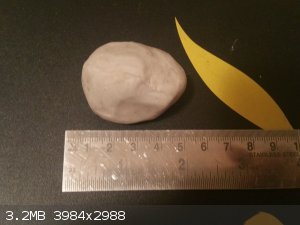
|
|
|
Hennig Brand
International Hazard
    
Posts: 1284
Registered: 7-6-2009
Member Is Offline
Mood: No Mood
|
|
Your plastic explosive looks good and it sounds like you did a much more thorough job of mixing and kneading than I have been doing. Seems like an
extreme amount of kneading though actually, I usually knead for 15-20 minutes maybe and that is with 100g quantities. Of course it really depends on
the particular mixture how much kneading is required and how much muscular endurance and intensity one can put forth as well.
I heard it stated that about 2lbs of plastic explosive was used in the first video, it does seem like a lot.
Assuming a hemispherical curved liner to keep this calculation more useful to us, which the Krakatoa liner used in the video is not, it is conical.
The Krakatoa comes with several different liners, one of them is in fact a dome shaped EFP liner. Using the following equation taken from the NG
thread for the volume of contents of a partially filled sphere to determine the amount of volume taken up by the liner and the volume of explosive
beside the liner:
Quote: Originally posted by Hennig Brand  |
Here are a couple of equations which could be useful to someone trying to perform heat transfer calculations based on a partially filled spherical
vessel/flask.
V = 1/3 * pi * H^2 * (3 * R - H)
A = 2 * pi * R * H
where:
V = Volume of contents in partially filled spherical vessel
A = Inside Surface Area of curved surface, next to contents, of partially filled spherical vessel
H = Height of contents in partially filled spherical vessel
R = Inner Radius of spherical vessel
Equations for other shapes can be found too, in texts or online.
|
If we assume the Krakatoa reliably gets 0.5D of penetration, 1 inch of penetration would require a 2 inch (ca. 5.1cm) charge. Assuming the explosive
head height is about the same as its diameter, assuming 0.15D for depth of curvature for the liner and given V = pi/4 * D^2 *L + [ pi/4 * D * H - 1/3
* pi * H^2 * (3 * R - H)], V = pi/4 * (5.1cm)^2 * 5.1cm + [ pi/4 * (5.1cm)^2 *0.77cm - 1/3 * pi * (0.77cm)^2 * (3 * 2.55cm - 0.77cm) ] = 115.6 cc. I
noticed in the first video that the explosive wrapper was labelled SEMTEX, so I will use an assumed density of 1.43g/cc, so the mass of explosive used
should be about 1.43g/cc * 115.6cc = ca. 165.3g or 0.36 lbs.
For the 1.9 inch steel target (same assumptions):
mass of explosive = pi/4 * (9.7cm)^2 * 9.7 + [ pi/4 * (9.7cm)^2 * 1.45cm - 1/3 * pi * (1.45cm)^2 * (3 * 4.85cm - 1.45cm) ] * 1.43g/cc
mass of explosive = 1137g of explosive or 2.50 lbs.
edit:
Just realized that I didn't account for liner thickness when I did the volume calculations. Oh well, close enough I think to make a reasonable
comparison.
Yeah the EFP and explosive charge that they used seems to be excessive overkill for the 1 inch plate, but not for the 1.9 inch plate. Then again there
are things to consider other than penetration. Penetration is the minimum usually before the target can be significantly damaged, but with a more
shallow and/or thicker liner the hole made could be much larger in diameter. The amount of damage done during and after penetration that is achieved
depends on the size of the hole and how much energy is left after penetration has been accomplished. There is more to EFP technology than just how
much steel is penetrated.
Edit:
Found the following from the Explosives.net site.
http://explosives.net/product/krakatoa/
"
The Krakatoa™ is a highly versatile and modular user-filled charge container for EOD and demolition both in air and under-water.
The Krakatoa™ replaces the Bigjet (MEPS) which has been in service for more than a decade. The new model has significant design improvements aimed
at enhancing both performance and usability, both in terms of modularity and user friendliness.
The charge may be orientated in any position. The charge container body is approximately 100mm in diameter x 100mm in length. There are two positions
for the projectile, giving two standard loads: 500g and 1000g of plastic explosive.
It is screw-consolidated and able to accept a range of projectiles for a variety of possible applications. Note the sighting arrangement on the body,
which can accept a red dot aiming device for longer-range, stand-off attack. It can also be able to receive sights and accessories equipped to fit the
Picatinny Rail which is supplied as part of the kit.
The Krakatoa™ Basic Kit is supplied with three charge bodies, a set of legs, a loading kit and sights. A tripod mount allows charges to be used with
any standard photographic tripod. The user selects the projectile for the job and fills the charge with plastic explosive.
The Krakatoa™ may be used underwater to depths of approximately 50m by the application of the Underwater Capsule which gives the charge an air gap
for jets and projectiles to form in. This makes the Krakatoa™ a completely non-magnetic charge suitable for use as a man-positioned mine
counter-charge for destroying magnetic influence sea mines."
So it is made to take either 500g or 1000g of explosive filler and there are a variety of different liners available for it. I can see how we could
easily make an underwater shaped charge or EFP as well, very interesting!
[Edited on 13-7-2015 by Hennig Brand]
"A risk-free world is a very dull world, one from which we are apt to learn little of consequence." -Geerat Vermeij
|
|
|
Hennig Brand
International Hazard
    
Posts: 1284
Registered: 7-6-2009
Member Is Offline
Mood: No Mood
|
|
Spherical Cap or Spherical Dome not Hemisphere
I thought that hemisphere was likely not the correct term to use to describe our EFP liners and it looks like it isn't.
https://en.wikipedia.org/wiki/Spherical_cap
https://en.wikipedia.org/wiki/Hemisphere
Calling the liner a domed disc would be correct as well, and maybe best.
[Edited on 13-7-2015 by Hennig Brand]
"A risk-free world is a very dull world, one from which we are apt to learn little of consequence." -Geerat Vermeij
|
|
|
markx
National Hazard
   
Posts: 646
Registered: 7-8-2003
Location: Northern kingdom
Member Is Offline
Mood: Very Jolly
|
|
Quote: Originally posted by greenlight  |
I just plasticized some PETN that had been recrystallized for the first time for use in EFP's.
I tried 13% Polybutene but it didn't seem enough and Semtex has 20% inert's I'm pretty sure so I bumped it up to 16% Polybutene and 6 drops motor oil
to add softness. It was rolled for about 2.5 hours
The result 31.9 grams PE is off white (due to the motor oil) and is slightly stiffer than Play doh.
The density was measured and is between 1.42-1.44.
[Edited on 12-7-2015 by greenlight] |
For loading of SC and EFP you do not need to have a literal plastique with excellent rheological properties, although it is a really cool thing to
achieve  Hence one can make do with much less inerts and physical work to only
reach phlegmatisation (5-10% is ok) and ease the loading and compaction of the charge. I've used 10% castor oil with PETN and RDX for SC
application...the mix is a crumbly granular matter that loads excellently and achieves good density. Hence one can make do with much less inerts and physical work to only
reach phlegmatisation (5-10% is ok) and ease the loading and compaction of the charge. I've used 10% castor oil with PETN and RDX for SC
application...the mix is a crumbly granular matter that loads excellently and achieves good density.
Exact science is a figment of imagination.......
|
|
|
greenlight
National Hazard
   
Posts: 737
Registered: 3-11-2014
Member Is Offline
Mood: Energetic
|
|
@Hennig, thanks, and I did roll it for a longer time than needed as it was staying too crumbly with just Polybutene and I was trying to hold out on
adding anything else. As soon as the small amount of motor oil was added it formed together much more efficiently as well as becoming softer.
@Markx, I realised when it was still crumbly that I could have used it in an EFP as is but I have always wanted the full plastique and as you say it
is a cool thing to acheive
I will try less Polybutene next time and try and bring the inert's % down but add a small amount of motor oil straight away instead of after adding
the 16% PB.
|
|
|
nux vomica
Hazard to Others
  
Posts: 267
Registered: 18-7-2013
Member Is Offline
Mood: No Mood
|
|
Has anyone seen this video I would have thought that it would have detonated the bombs https://www.youtube.com/watch?feature=player_detailpage&v=xAmraOEGzqU
Anyway tried out my new ebw fireset the setup was 1.2 grams of etn compressed to 1.3 grams c/c plus 0.1 on top for a total of 1.3 grms of etn the
copper dish was 6.25mm rad, 0.6mm thick and 11.5 mm dia ,bridge wire 0.030mm dia x 2mm long, coax 7 meters with 200mm twin core on the end connecting
with a jst to the shaped charge 10mm ms plate at 40 mm standoff, and yes I have a voltage measurement of 3500v at detonation.
cheers nuxy
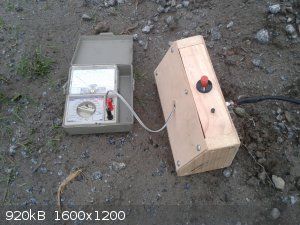 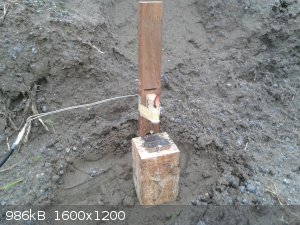 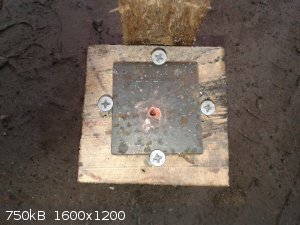 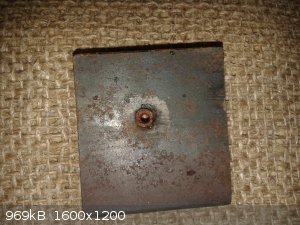 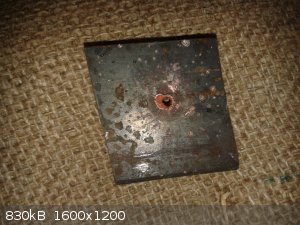
[Edited on 13-7-2015 by nux vomica]
|
|
|
greenlight
National Hazard
   
Posts: 737
Registered: 3-11-2014
Member Is Offline
Mood: Energetic
|
|
@Nux, was your liner conical in shape and was the target 10mm thick steel plate?
It appears that in the video they are placing shaped charges in an exact location on the unexploded bomb so that the jet penetrates and destroys a
part of the firing train or fuze assembly.
With the sensitive initiation system removed or interrupted, the rest of the unexploded bomb is much less sensitive and my guess would be able to be
removed by hand.
I think they are using the Vulcan shaped charge from Alford technologies with a liquid projectile liner which will penetrate the thick casing and
destroy/remove the fuze assembly but does not detonate the HE filler.
http://explosives.net/product/vulcan/
[Edited on 13-7-2015 by greenlight]
|
|
|
nux vomica
Hazard to Others
  
Posts: 267
Registered: 18-7-2013
Member Is Offline
Mood: No Mood
|
|
As I understand it it sets off the main charge but only a low order explosion ie not a complete detonation you can see the casing has split open like
a gas cylinder that has ruptured in a fire.
|
|
|
greenlight
National Hazard
   
Posts: 737
Registered: 3-11-2014
Member Is Offline
Mood: Energetic
|
|
From the Alford Tech website: "The Vulcan™ Liquid Projectile Set comprises a pair of thin-walled plastic cones with water between them. These
constitute a composite projectile which penetrates steel-cased munitions with wall thickness of up to 10mm. Used to eject fuses and disperse charge
contents with minimal risk of detonation."
I don't think it detonates the main charge at all I think the water jet just punches through and ruptures the container and ejects the fuze assembly.
Was your liner conical in the test you performed above?
|
|
|
nux vomica
Hazard to Others
  
Posts: 267
Registered: 18-7-2013
Member Is Offline
Mood: No Mood
|
|
No it is spherical and the steel was 10 mm thick the same setup as the ones on the ebw thread .
[Edited on 13-7-2015 by nux vomica]
|
|
|
greenlight
National Hazard
   
Posts: 737
Registered: 3-11-2014
Member Is Offline
Mood: Energetic
|
|
That is quite a good result for using 1.3 grams of explosive!
Is your casing made of metal?
It would be interesting to try one of these liners containing a water jacket which forms a jet.
There is also a magnesium EFP liner as an option with the Vulcan shaped charge which burns when it forms and can ignite or initiate combustibles or
explosives behind the target as well as penetrating steel which sounds pretty interesting.
[Edited on 13-7-2015 by greenlight]
|
|
|
nux vomica
Hazard to Others
  
Posts: 267
Registered: 18-7-2013
Member Is Offline
Mood: No Mood
|
|
The caseing is a s/s m10 rivnut we have a couple of hundred of them at work
|
|
|
Hennig Brand
International Hazard
    
Posts: 1284
Registered: 7-6-2009
Member Is Offline
Mood: No Mood
|
|
Nice compact looking fireset you have made and another successful shaped charge test as well!
Could you tell me what the diameter of the entrance and exit holes are in the 10mm thick steel plate?
Greenlight, it is a good result for 1.3g of explosive, but even though possibly hard to believe the amount of explosive used is proportionately
similar to what I have been using in relation to the diameter of the charge. The amount of explosive required goes up exponentially with the diameter
of the charge. Assuming an explosive head height approximately equal to the diameter, V = pi/4 * D^3, so to compare a 24mm charge to a 11.5mm charge,
(24mm / 11.5mm)^3 = ca. 9.1 times the volume of explosive. Assuming equal explosive densities, 1.3g * 9.1 = 11.83g for the 24mm charge. I used 12.2g,
but then again it was 87% ETN and 13% inert material and also the plastic explosive density was about 1.4g/cc.
[Edited on 13-7-2015 by Hennig Brand]
"A risk-free world is a very dull world, one from which we are apt to learn little of consequence." -Geerat Vermeij
|
|
|
greenlight
National Hazard
   
Posts: 737
Registered: 3-11-2014
Member Is Offline
Mood: Energetic
|
|
Ah, yes, I see what you mean now Hennig and the diameter of the Nux's charge is only 6.25mm compared to your 24 mm.
What do you think of these magnesium liners for EFP, they may be something interesting to experiment with in the future as you can buy magnesium sheet
on ebay.
http://explosives.net/product/vulcan-magnesium-efp-set/
|
|
|
Hennig Brand
International Hazard
    
Posts: 1284
Registered: 7-6-2009
Member Is Offline
Mood: No Mood
|
|
I believe 6.25mm is the radius of curvature, the diameter is 11.5mm.
I saw that EFP product with the magnesium liner being used as part of a demonstration in a program on the Discovery channel years ago. For specialized
applications it could be useful.
"A risk-free world is a very dull world, one from which we are apt to learn little of consequence." -Geerat Vermeij
|
|
|
greenlight
National Hazard
   
Posts: 737
Registered: 3-11-2014
Member Is Offline
Mood: Energetic
|
|
Damn, I misunderstood again
I've got it now.
I think I will order some 1mm magnesium sheet to experiment with when i have these copper lined EFP's dialed in correctly.
|
|
|
Laboratory of Liptakov
International Hazard
    
Posts: 1387
Registered: 2-9-2014
Location: Technion Haifa
Member Is Offline
Mood: old jew
|
|
efp
My opinion is this: 1.3 g ETN has no power to pierce 10 mm of steel. In any assembly like the photo. The author makes fun of you. Liptakov.
|
|
|
Hennig Brand
International Hazard
    
Posts: 1284
Registered: 7-6-2009
Member Is Offline
Mood: No Mood
|
|
I had that thought at first, but when I looked at it more closely and thought about it a bit I now think he is probably being straight. His charge is
only 11.5mm in diameter, which requires a volume of explosive to have approximately 1D in explosive head height of about V = pi/4 * D^3 = pi/4 *
(1.15cm)^3 = 1.19 cc. His explosive density was stated as 1.3g/cc, which would give a charge mas of m = 1.3g/cc * 1.19cc = 1.55g. Ok, so he used a
little less but we are still in the ball park. This doesn't count his 0.1g ETN prime either.
Remember this test I performed with a conical steel liner earlier in this thread?
http://www.sciencemadness.org/talk/viewthread.php?tid=10575&...
Explosive: 5g of 80% ETN Plastique
Penetration: 1.125 inches or ca. 2.86cm (28.6mm)
So that test used only 4g of ETN and penetrated 28.6mm of steel. Since penetration is proportional to energy (assuming same diameter holes), as a
first approximation 4g/1.3g * 10mm = 30.8mm which is only 7.7% higher than what I got and he was using pure ETN and a copper liner while I was using
80% ETN plastique and a steel liner which both give lower shaped charge performance. I believe that much is possible. What is a little strange is
exactly how he is getting such a small diameter hole and such deep penetration with such short standoff unless his charge is really functioning as a
Munroe effect shaped charge (jetting charge).
The thickness of the liner he used also seems too thick to easily form into a tight projectile, but then again he used very brisant pure ETN and I
think we are talking Munroe effect again and also he used a very strong steel casing as well, which I am sure makes a huge difference especially with
small charges such as these.
Knowing the volume of the hole would allow a good comparison to be made.
[Edited on 14-7-2015 by Hennig Brand]
"A risk-free world is a very dull world, one from which we are apt to learn little of consequence." -Geerat Vermeij
|
|
|
nux vomica
Hazard to Others
  
Posts: 267
Registered: 18-7-2013
Member Is Offline
Mood: No Mood
|
|
I can get a 2.5 mm drill almost through from the exit side there's a burr on the entry side stopping it .
the photo is with a piece of 2.4mm welding wire.
Cheers nuxy
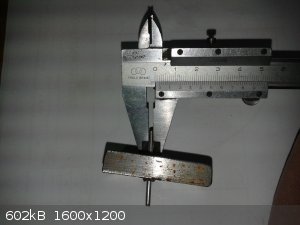
[Edited on 14-7-2015 by nux vomica]
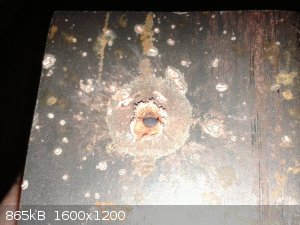 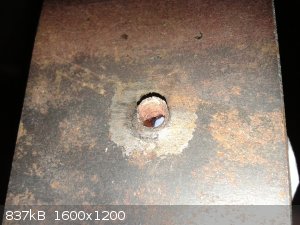
|
|
|
Hennig Brand
International Hazard
    
Posts: 1284
Registered: 7-6-2009
Member Is Offline
Mood: No Mood
|
|
According to "Fundamentals of Shaped Charges", by Walters and Zukas, for a given explosive charge the volume of the penetration should be
approximately the same regardless of what type of device it was used in, EFP, SC, fragmentation, etc.
Here is a link to where the section from the text was discussed and the table from the text is attached:
http://www.sciencemadness.org/talk/viewthread.php?tid=10575&...
My volume from the test above:
Explosive used: 12.2g of 87% ETN plastique
Average diameter of hole: ca. 12mm (1.2cm)
Penetration: 1/2" or 12.7mm (1.27cm)
V = pi/4 * (1.2cm)^2 * 1.27cm
V = 1.44 cc or 1.44 mL
From Nux's test:
Explosive used: 1.3g of ETN
Average diameter of hole: ca. 2.5mm (0.25cm)
Penetration: 10mm (1cm)
V = pi/4 * (0.25cm)^2 * 1cm
V = 0.05 cc or 0.05 mL
Comparison:
factor = 1.44cc / 0.05cc = 28.8
assume equal explosives, just to get a ball park comparison:
28.8 * 1.3g = 37.4g......but I only used 12.2g and it was 87% ETN and 13% inert material.
My test produced a much higher volume penetration in proportion to the mass of the explosive charge used. I think his test was fair, but I still think
he is getting a jetting charge not a EFP judging by the penetration depth, how small the diameter of the hole is and the extremely short standoff
used.
[Edited on 14-7-2015 by Hennig Brand]
"A risk-free world is a very dull world, one from which we are apt to learn little of consequence." -Geerat Vermeij
|
|
|
nux vomica
Hazard to Others
  
Posts: 267
Registered: 18-7-2013
Member Is Offline
Mood: No Mood
|
|
I did just penertrate that 16mm target in the ebw thread and that was 50mm standoff.
|
|
|
Hennig Brand
International Hazard
    
Posts: 1284
Registered: 7-6-2009
Member Is Offline
Mood: No Mood
|
|
Yeah, I remember now that you mention it. That amount of penetration and holes that small in diameter are not characteristic of EFPs, especially at
such short standoffs. A well made Munroe effect shaped charge can still work quite well at the standoffs you are using and it looks like you are one
of the ones here most able to do accurate and precise work. Very nice tests, interesting! 
Maybe they are some sort of transition type charge, not really an EFP and not really a Munroe effect SC, but somewhere in-between?
[Edited on 14-7-2015 by Hennig Brand]
"A risk-free world is a very dull world, one from which we are apt to learn little of consequence." -Geerat Vermeij
|
|
|
| Pages:
1
..
43
44
45
46
47
..
68 |